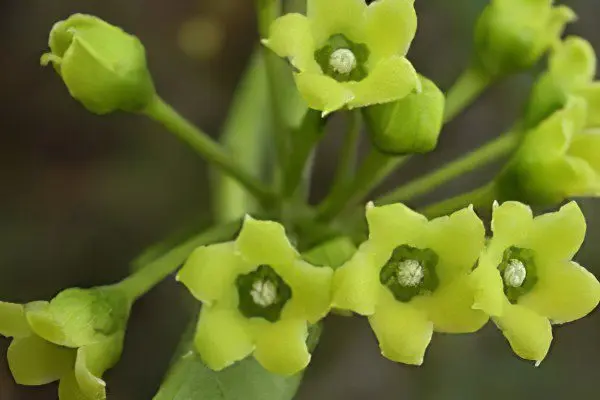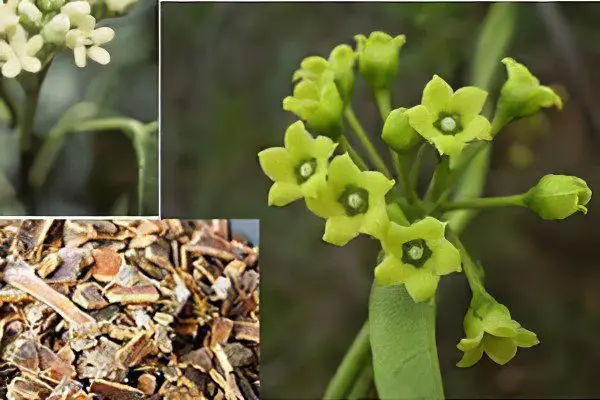Contents
Useful properties and application of kondurango
Description of kondurango

The unique kondurango is a beautiful vine climbing and climbing trees. The trunk of the presented plant often reaches 10 cm in thickness. The diameter of the stems also differs in solid thickness. Creeping young branches of such a shrub are covered with an unusual felt pubescence of a greenish-olive hue. Heart-shaped oval opposite leaves of petiolate type are pubescent on both sides. The leaves are approximately 10-11 cm long, while their width reaches 8 cm.
The rough leaf blade is broadly ovate. The small greenish flowers of the plant are collected in graceful dichotomous inflorescences that stand out from each corner of the leaves. In the wild, this vine is found in Ecuador, on the slopes of the western Cordillera, in Colombia, Peru, Argentina, and also in South America. In addition, the shrub is widely cultivated in areas of East Africa.
For medicinal purposes, as a rule, only the bark of this wonderful plant is used. The bark is usually collected in gutter-like pieces. It is a small tube or ring from 5 to 15 cm in length. The width of the bark prepared for use should be at least 1 cm. Often the bark has a warped or twisted shape, which corresponds to the bends of the creeping stem.
The outer surface of this grayish-brown bark is bumpy, and the inner side has a yellowish tint and longitudinal grooves. From its smooth fractures of the bark, long soft fibers can stick out in places. The taste is bitter-astringent.
Useful properties of kondurango
The active ingredients of such a shrub are flavonoids and coumarins, essential oils in small quantities, as well as bitter kondurangin. The roots of this creeper are characterized by a weak aroma and a bitter-astringent taste. Condurangoglycoside in the bark contains approximately 2,5%. It is formed by five molecules of monosaccharides and a special genin condurangin. They also include glucose and deoxysugar. Acetic and cinnamic acids are always split off during the hydrolysis of the glycoside.
Due to the presence of bitterness, kondurango perfectly helps with general weakness, a decrease in the normal secretion of gastric juice and loss of appetite. To date, the use of this drug is recommended to strengthen the stomach and to significantly improve the functions of digestion.
Application of kondurango

Since the end of the 19th century, kondurango has been widely used in medicine to treat various ailments. The astringent bark of such a magnificent plant was often used in the treatment of cancer and syphilis. With a rather weak secretion of gastric juice, it has a positive effect. Also, to relieve pain in various diseases of the digestive tract, an exceptionally useful tea from kondurango is shown. Moreover, modern specialists have proven high efficiency in the most severe forms of gastric catarrh.
In ancient times, a special powder from kondurango was used for the bites of poisonous snakes. For the treatment of extensive wounds and purulent wounds, bark powder is applied externally. The bitter bark of the plant perfectly restores appetite, significantly improving well-being.
To prepare tea from kondurango, it is recommended to pour 2 tsp. chopped bark 250 ml cold water. Bring the mixture to a boil very slowly and then cool completely. Boiling the drink is strictly contraindicated. After filtering, it is recommended to heat the product to the usual warm state, suitable for drinking. It should be noted that the bark of the plant is practically insoluble at high temperatures.
Such a healing tea from kondurango should be drunk one cup before each meal. Experts do not advise sweetening it. Each dose must be drunk necessarily in small sips, which contributes to its better absorption and mild effect on the gastric mucosa.
In homeopathy, a special preparation based on this plant is used. It is indicated for the treatment of various gastric diseases and decreased appetite. This remarkable preparation of Kondurango is indicated in D1 dilutions. The medicine should be taken approximately 5 drops no more than 5 times a day. With long-term treatment with such a great drug, you can feel better and get rid of stomach pain.
Contraindications condurango
Due to the bitter taste of the bark of such a shrub, an overdose is completely excluded. No side effects were observed at therapeutic doses. When used correctly in acceptable dosages, kondurango is not contraindicated even for children and expectant mothers.









